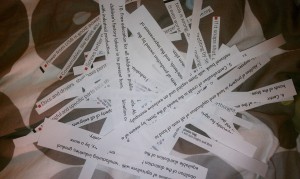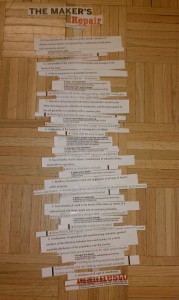Concept: Inspired by The Cut-Up Method of Brion Gysin, by William S. Burroughs, I decided to write an all-encompassing Manifesto for designers.
Strategy: This Manifesto would be a combination of three other Manifestos:
- The Repair Manifesto by Platform 21, which encourages design of products and systems that are repairable and thus live extensive, meaningful lives.
- The Maker’s Bill of Rights by Make Magazine, which encourages open-source electronics and design.
- And a summary of The Communist Manifesto, the influential document outlining the Communist party’s beliefs.
These three Manifestos, while different in content and meaning, all encompass similar ideals: making things accessible to the masses and long lasting.
Manifestation:
I started by rearranging each Manifesto separately, by using Burroughs first suggestion:
The method is simple. Here is one way to do it. Take a page. Like this page. Now cut down the middle and cross the middle. You have four sections: 1 2 3 4 . . . one two three four. Now rearrange the sections placing section four with section one and section two with section three. And you have a new page.
I then cut up each Manifesto, leaving each point in tact. I was left with a pile of strips of paper, which I arranged randomly to get my new Manifesto.
The Maker’s Repair Communist Manifesto
- Free education for all children in public schools. Abolition of children’s factory labour in its present form. Combination of education with industrial production.
- Repaired things are unique. Even fakes become originals when you repair them.
- Torx is OK; tamperproof is rarely OK.
- Stop Recycling. Start Repairing.
- Centralisation of the means of communication and transport in the hands of the State
- A heavy progressive or graduated income tax.
- Batteries shall be replaceable.
- Repair – even in good times! If you think this manifesto has to do with the recession, forget it. This isn’t about money, it’s about a mentality.
- What doesn’t kill it makes it stronger. Every time we repair something, we add to its potential, its history, its soul and its inherent beauty.
- Components, not entire sub-assemblies, shall be replaceable.
- If it snaps shut, it shall snap open.
- Extension of factories and instruments of production owned by the State; the bringing into cultivation of waste-lands, and the improvement of the soil generally in accordance with a common plan.
- Meaningful and specific parts lists shall be included.
- You can repair anything, even a plastic bag. But we’d recommend getting a bag that will last longer, and then repairing it if necessary.
- Consumables, like fuses and filters, shall be easy to access.
- Confiscation of the property of all emigrants and rebels.
- Cases shall be easy to open.
- Things should be designed so that they can be repaired. Product designers: Make your products repairable. Share clear, understandable information about DIY repairs. Consumers: Buy things you know can be repaired, or else find out why they don’t exist. Be critical and inquisitive.
- Repairing is about independence. Don’t be a slave to technology – be its master. If it’s broken, fix it and make it better. And if you’re a master, empower others.
- Standard connectors shall have pin-outs defined.
- Equal liability of all to labour. Establishment of industrial armies, especially for agriculture.
- Metric or standard, not both.
- Repair survives fashion. Repair is not about styling or trends. There are no due-dates for repairable items.
- Abolition of property in land and application of all rents of land to public purposes.
- Docs and drivers shall have permalinks and shall reside for all perpetuity at archive.org.
- Circuit boards shall be commented.
- Repair is not replacement. Replacement is throwing away the broken bit. This is NOT the kind of repair that we’re talking about.
- Centralisation of credit in the hands of the State, by means of a national bank with State capital and an exclusive monopoly.
- Ease of repair shall be a design ideal, not an afterthought.
- Repairing is a creative challenge. Making repairs is good for the imagination. Using new techniques, tools, and materials ushers in possibility rather than dead ends.
- Schematics shall be included.
- Power from USB is good; power from proprietary power adapters is bad.
- Combination of agriculture with manufacturing industries; gradual abolition of the distinction between town and country, by a more equitable distribution of the population over the country.
- Special tools are allowed only for darn good reasons.
- To repair is to discover. As you fix objects, you’ll learn amazing things about how they actually work. Or don’t work.
- Profiting by selling expensive special tools is wrong, and not making special tools available is even worse.
- Abolition of all right of inheritance.
- Make your products live longer! Repairing means taking the opportunity to give your product a second life. Don’t ditch it, stitch it! Don’t end it, mend it! Repairing is not anti-consumption. It is anti- needlessly throwing things away.

